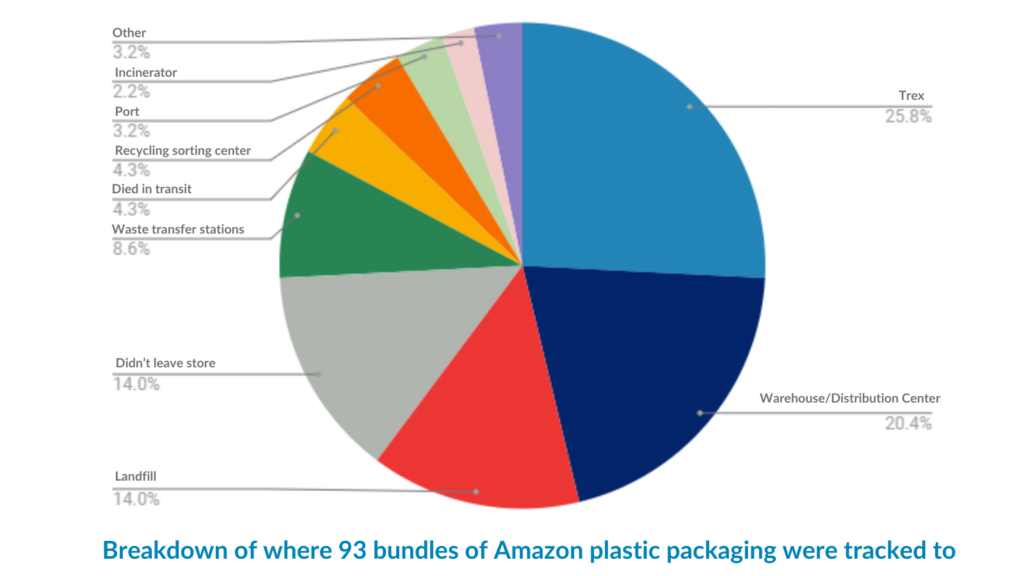Jenn Engstrom
State Director, CALPIRG Education Fund
State Director, CALPIRG Education Fund
State Director, Environment Oregon Research & Policy Center
Tracking investigation finds store drop off system for recycling plastic packaging is failing
LOS ANGELES — A new report from U.S. PIRG Education Fund and Environment America Research & Policy Center found that Amazon packaging rarely gets recycled when customers use the company’s recommended store drop-off system. The report, Truth in Recycling: Does Amazon’s Plastic Packaging Actually Get Recycled?, released Tuesday, shows how packaging from drop-off bins ended up in landfills or incinerators, stuck in distribution centers or made into nonrecyclable products.
“Nearly every time we order something from Amazon, we’re left with a pile of plastic packaging, which becomes waste as soon as our packages are opened,” said Jenn Engstrom, state director of CALPIRG Education Fund and author of the report. “We already knew that plastic is hard to recycle and that the rates of recycling all types of plastic, especially plastic film, are abysmal. We were skeptical that the store drop-off system that Amazon instructs customers to use is working and we were right.”
Staff and volunteers with the U.S. PIRG Education Fund and Environment America Research & Policy Center in eight states put 93 tracking devices inside Amazon plastic packaging and placed them in recycling store drop off bins. After following the instructions Amazon included on its packaging, only four packages with trackers inside ended up in a material recovery center that sorts items for recycling. Thirteen trackers ended up in landfills, two went to an incinerator and three went to the Port of Los Angeles.

Photo by Staff | TPIN
The most common destination for the tracking devices – 24 of 93 – was a company called Trex Company, Inc. Trex mixes plastic film with sawdust to make benches and decking, rendering the plastic’s new form nonrecyclable.
“Turning Amazon plastic packaging into nonrecyclable products might be better than throwing it away, but this process, called downcycling, is not the same as recycling. Downcycling still doesn’t close the loop on plastic production,” said Celeste Meiffren-Swango, Beyond Plastic campaign director with Environment America Research & Policy Center. “To solve our plastic waste crisis, we need solutions that reduce the need to bring more plastic into our world.”
As one of the largest retailers in the world, Amazon is a huge contributor to plastic waste. A 2021 report from the ocean conservation group Oceana estimated that Amazon generated 709 million pounds of plastic waste globally, which it estimates is enough to circle Earth more than 800 times in the form of the air pillows commonly used in packaging.
Less than 10% of all produced plastic has been recycled. The rest ends up being incinerated, overflowing landfills, littering our streets, polluting the ocean and harming wildlife. In our environment, plastic does not degrade. Instead, it breaks into smaller pieces, called microplastics, that have been discovered in every corner of the globe. Microplastics have even been found inside human bodies.
The U.S. PIRG Education Fund and Environment America Research & Policy Center joined other environmental groups and collectively submitted 138,000 petitions to Amazon headquarters calling on the company to eliminate plastic in its U.S. shipments. Amazon has already committed to eliminating plastic packaging in Europe, India and Japan. In the U.S., the company has committed to phasing out the use of its plastic padded mailer, though without a timeline.
“We hope our investigation makes it clear to Amazon that recycling plastic is not the answer, especially relying on a store drop off system that uses an awful lot of infrastructure and energy to transport plastic around the country just to be downcycled or landfilled,” said Engstrom. “It’s time for Amazon to eliminate plastic packaging in its shipments.”
